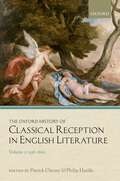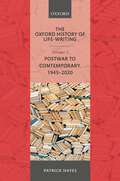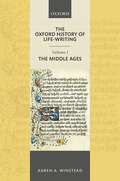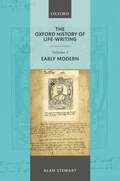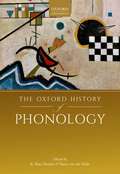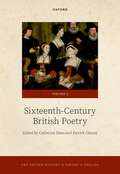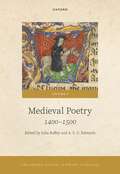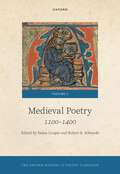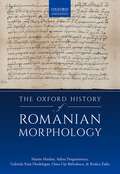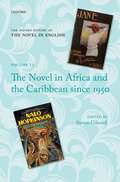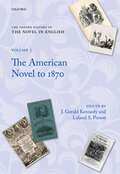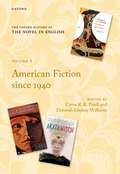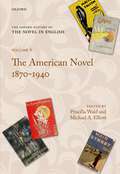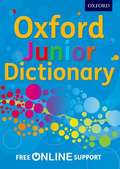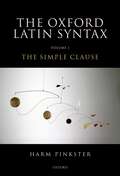- Table View
- List View
The Oxford History of Classical Reception in English Literature: Volume 2: 1558-1660 (Oxford History of Classical Reception in English Literature)
The Oxford History of Classical Reception (OHCREL) is designed to offer a comprehensive investigation of the numerous and diverse ways in which literary texts of the classical world have stimulated responses and refashioning by English writers. Covering the full range of English literature from the early Middle Ages to the present day, OHCREL both synthesizes existing scholarship and presents cutting-edge new research, employing an international team of expert contributors for each of the five volumes. OHCREL endeavours to interrogate, rather than inertly reiterate, conventional assumptions about literary 'periods', the processes of canon-formation, and the relations between literary and non-literary discourse. It conceives of 'reception' as a complex process of dialogic exchange and, rather than offering large cultural generalizations, it engages in close critical analysis of literary texts. It explores in detail the ways in which English writers' engagement with classical literature casts as much light on the classical originals as it does on the English writers' own cultural context. This second volume covers the years 1558-1660, and explores the reception of the ancient genres and authors in English Renaissance literature, engaging with the major, and many of the minor, writers of the period, including Shakespeare, Marlowe, Spenser, and Jonson. Separate chapters examine the Renaissance institutions and contexts which shape the reception of antiquity, and an annotated bibliography provides substantial material for further reading.
The Oxford History of Life-Writing: Volume 7: Postwar to Contemporary, 1945-2020 (Oxford History of Life-Writing)
by Patrick HayesWith the growing urgency of questions about how to claim identity and achieve authenticity, life-writing started to acquire an unprecedented cultural importance. A range of social and economic developments, from the publishing boom in memoir writing to the rise of the internet, transformed the possibilities for self-expression. By the end of the timespan covered in this book life-writing was no longer something done mainly by important individuals who wrote their autobiography, or by sensitive souls who kept a diary. It became a truly ubiquitous phenomenon, part and parcel of the everyday formation of selfhood. Considering a diverse range of texts from across the English-speaking world, this volume places life-writing in relation to wider debates about the sociology and philosophy of modern identity, and the changing marketplace of publishing and bookselling. Yet in doing so it seeks above all to credit the extraordinary literary inventiveness which the pursuit of self-knowledge inspired in this period. Major subjects addressed include: the aftermath of World War II, including responses to the Holocaust; the impact of psychoanalysis on biography; autofiction, autrebiography, and changing ideas about authentic self-knowledge; coming out memoirs and the transformation of sexual identity; feminist exemplary writing and lyric poetry; multilingualism and intercultural life-writing; the memoir boom and the decline of intimacy; testimony narrative and memory culture; posthumanism in theory and practice; literary biography as an alternative to literary theory; literary celebrity and its consequences for literature; social media and digital life-writing.
The Oxford History of Life-Writing: Volume 7: Postwar to Contemporary, 1945-2020 (Oxford History of Life-Writing)
by Patrick HayesWith the growing urgency of questions about how to claim identity and achieve authenticity, life-writing started to acquire an unprecedented cultural importance. A range of social and economic developments, from the publishing boom in memoir writing to the rise of the internet, transformed the possibilities for self-expression. By the end of the timespan covered in this book life-writing was no longer something done mainly by important individuals who wrote their autobiography, or by sensitive souls who kept a diary. It became a truly ubiquitous phenomenon, part and parcel of the everyday formation of selfhood. Considering a diverse range of texts from across the English-speaking world, this volume places life-writing in relation to wider debates about the sociology and philosophy of modern identity, and the changing marketplace of publishing and bookselling. Yet in doing so it seeks above all to credit the extraordinary literary inventiveness which the pursuit of self-knowledge inspired in this period. Major subjects addressed include: the aftermath of World War II, including responses to the Holocaust; the impact of psychoanalysis on biography; autofiction, autrebiography, and changing ideas about authentic self-knowledge; coming out memoirs and the transformation of sexual identity; feminist exemplary writing and lyric poetry; multilingualism and intercultural life-writing; the memoir boom and the decline of intimacy; testimony narrative and memory culture; posthumanism in theory and practice; literary biography as an alternative to literary theory; literary celebrity and its consequences for literature; social media and digital life-writing.
The Oxford History of Life-Writing: Volume 1. The Middle Ages (Oxford History of Life-Writing)
by Karen A. WinsteadThe Oxford History of Life-Writing: Volume 1: The Middle Ages explores the richness and variety of life-writing from late Antiquity to the threshold of the Renaissance. During the Middle Ages, writers from Bede to Chaucer were thinking about life and experimenting with ways to translate lives, their own and others', into literature. Their subjects included career religious, saints, celebrities, visionaries, pilgrims, princes, philosophers, poets, and even a few 'ordinary people.' They relay life stories not only in chronological narratives, but also in debates, dialogues, visions, and letters. Many medieval biographers relied on the reader's trust in their authority, but some espoused standards of evidence that seem distinctly modern, drawing on reliable written sources, interviewing eyewitnesses, and cross-checking their facts wherever possible. Others still professed allegiance to evidence but nonetheless freely embellished and invented not only events and dialogue but the sources to support them. The first book devoted to life-writing in medieval England, The Oxford History of Life-Writing: Volume 1: The Middle Ages covers major life stories in Old and Middle English, Latin, and French, along with such Continental classics as the letters of Abelard and Heloise and the autobiographical Vision of Christine de Pizan. In addition to the life stories of historical figures, it treats accounts of fictional heroes, from Beowulf to King Arthur to Queen Katherine of Alexandria, which show medieval authors experimenting with, adapting, and expanding the conventions of life writing. Though Medieval life writings can be challenging to read, we encounter in them the antecedents of many of our own diverse biographical forms-tabloid lives, literary lives, brief lives, revisionist lives; lives of political figures, memoirs, fictional lives, and psychologically-oriented accounts that register the inner lives of their subjects.
The Oxford History of Life-Writing: Volume 1. The Middle Ages (Oxford History of Life-Writing)
by Karen A. WinsteadThe Oxford History of Life-Writing: Volume 1: The Middle Ages explores the richness and variety of life-writing from late Antiquity to the threshold of the Renaissance. During the Middle Ages, writers from Bede to Chaucer were thinking about life and experimenting with ways to translate lives, their own and others', into literature. Their subjects included career religious, saints, celebrities, visionaries, pilgrims, princes, philosophers, poets, and even a few 'ordinary people.' They relay life stories not only in chronological narratives, but also in debates, dialogues, visions, and letters. Many medieval biographers relied on the reader's trust in their authority, but some espoused standards of evidence that seem distinctly modern, drawing on reliable written sources, interviewing eyewitnesses, and cross-checking their facts wherever possible. Others still professed allegiance to evidence but nonetheless freely embellished and invented not only events and dialogue but the sources to support them. The first book devoted to life-writing in medieval England, The Oxford History of Life-Writing: Volume 1: The Middle Ages covers major life stories in Old and Middle English, Latin, and French, along with such Continental classics as the letters of Abelard and Heloise and the autobiographical Vision of Christine de Pizan. In addition to the life stories of historical figures, it treats accounts of fictional heroes, from Beowulf to King Arthur to Queen Katherine of Alexandria, which show medieval authors experimenting with, adapting, and expanding the conventions of life writing. Though Medieval life writings can be challenging to read, we encounter in them the antecedents of many of our own diverse biographical forms-tabloid lives, literary lives, brief lives, revisionist lives; lives of political figures, memoirs, fictional lives, and psychologically-oriented accounts that register the inner lives of their subjects.
The Oxford History of Life Writing: Volume 2. Early Modern (Oxford History of Life-Writing)
by Alan StewartThe Oxford History of Life-Writing: Volume2. Early Modern explores life-writing in England between 1500 and 1700, and argues that this was a period which saw remarkable innovations in biography, autobiography, and diary-keeping that laid the foundations for our modern life-writing. The challenges wrought by the upheavals and the sixteenth-century English Reformation and seventeenth-century Civil Wars moulded British and early American life-writing in unique and lasting ways. While classical and medieval models continued to exercise considerable influence, new forms began to challenge them. The English Reformation banished the saints' lives that dominated the writings of medieval Catholicism, only to replace them with new lives of Protestant martyrs. Novel forms of self-accounting came into existence: from the daily moral self-accounting dictated by strands of Calvinism, to the daily financial self-accounting modelled on the new double-entry book-keeping. This volume shows how the most ostensibly private journals were circulated to build godly communities; how women found new modes of recording and understanding their disrupted lives; how men started to compartmentalize their lives for public and private consumption. The volume doesn't intend to present a strict chronological progression from the medieval to the modern, nor to suggest the triumphant rise of the fact-based historical biography. Instead, it portrays early modern England as a site of multiple, sometimes conflicting possibilities for life-writing, all of which have something to teach us about how the period understood both the concept of a 'life' and what it mean to 'write' a life.
The Oxford History of Life Writing: Volume 2. Early Modern (Oxford History of Life-Writing)
by Alan StewartThe Oxford History of Life-Writing: Volume2. Early Modern explores life-writing in England between 1500 and 1700, and argues that this was a period which saw remarkable innovations in biography, autobiography, and diary-keeping that laid the foundations for our modern life-writing. The challenges wrought by the upheavals and the sixteenth-century English Reformation and seventeenth-century Civil Wars moulded British and early American life-writing in unique and lasting ways. While classical and medieval models continued to exercise considerable influence, new forms began to challenge them. The English Reformation banished the saints' lives that dominated the writings of medieval Catholicism, only to replace them with new lives of Protestant martyrs. Novel forms of self-accounting came into existence: from the daily moral self-accounting dictated by strands of Calvinism, to the daily financial self-accounting modelled on the new double-entry book-keeping. This volume shows how the most ostensibly private journals were circulated to build godly communities; how women found new modes of recording and understanding their disrupted lives; how men started to compartmentalize their lives for public and private consumption. The volume doesn't intend to present a strict chronological progression from the medieval to the modern, nor to suggest the triumphant rise of the fact-based historical biography. Instead, it portrays early modern England as a site of multiple, sometimes conflicting possibilities for life-writing, all of which have something to teach us about how the period understood both the concept of a 'life' and what it mean to 'write' a life.
The Oxford History of Phonology
by Harry van der Hulst B. Elan DresherThis volume is the first to provide an up-to-date and comprehensive history of phonology from the earliest known examples of phonological thinking, through the rise of phonology as a field in the twentieth century, and up to the most recent advances. The volume is divided into five parts. Part I offers an account of writing systems along with chapters exploring the great ancient and medieval intellectual traditions of phonological thought that form the foundation of later thinking and continue to enrich phonological theory. Chapters in Part II describe the important schools and individuals of the late nineteenth and early twentieth centuries who shaped phonology as an organized scientific field. Part III examines mid-twentieth century developments in phonology in the Soviet Union, Northern and Western Europe, and North America; it continues with precursors to generative grammar, and culminates in a chapter on Chomsky and Halle's The Sound Pattern of English (SPE). Part IV then shows how phonological theorists responded to SPE with respect to derivations, representations, and phonology-morphology interaction. Theories discussed include Dependency Phonology, Government Phonology, Constraint-and-Repair theories, and Optimality Theory. The part ends with a chapter on the study of variation. Finally, chapters in Part V look at new methods and approaches, covering phonetic explanation, corpora and phonological analysis, probabilistic phonology, computational modelling, models of phonological learning, and the evolution of phonology. This in-depth exploration of the history of phonology provides new perspectives on where phonology has been and sheds light on where it could go next.
The Oxford History of Phonology
This volume is the first to provide an up-to-date and comprehensive history of phonology from the earliest known examples of phonological thinking, through the rise of phonology as a field in the twentieth century, and up to the most recent advances. The volume is divided into five parts. Part I offers an account of writing systems along with chapters exploring the great ancient and medieval intellectual traditions of phonological thought that form the foundation of later thinking and continue to enrich phonological theory. Chapters in Part II describe the important schools and individuals of the late nineteenth and early twentieth centuries who shaped phonology as an organized scientific field. Part III examines mid-twentieth century developments in phonology in the Soviet Union, Northern and Western Europe, and North America; it continues with precursors to generative grammar, and culminates in a chapter on Chomsky and Halle's The Sound Pattern of English (SPE). Part IV then shows how phonological theorists responded to SPE with respect to derivations, representations, and phonology-morphology interaction. Theories discussed include Dependency Phonology, Government Phonology, Constraint-and-Repair theories, and Optimality Theory. The part ends with a chapter on the study of variation. Finally, chapters in Part V look at new methods and approaches, covering phonetic explanation, corpora and phonological analysis, probabilistic phonology, computational modelling, models of phonological learning, and the evolution of phonology. This in-depth exploration of the history of phonology provides new perspectives on where phonology has been and sheds light on where it could go next.
The Oxford History of Poetry in English: Volume 4. Sixteenth-Century British Poetry (Oxford History of Poetry in English)
by Catherine Bates Patrick CheneyThe Oxford History of Poetry in English is designed to offer a fresh, multi-voiced, and comprehensive analysis of 'poetry': from Anglo-Saxon culture through contemporary British, Irish, American, and Global culture, including English, Scottish, and Welsh poetry, Anglo-American colonial and post-colonial poetry, and poetry in Canada, Australia, New Zealand, the Caribbean, India, Africa, Asia, and other international locales. The series both synthesises existing scholarship and presents cutting-edge research, employing a global team of expert contributors for each of the volumes. Sixteenth-Century British Poetry features a history of the birth moment of modern 'English' poetry in greater detail than previous studies. It examines the literary transitions, institutional contexts, artistic practices, and literary genres within which poets compose their works. Each chapter combines an orientation to its topic and a contribution to the field. Specifically, the volume introduces a narrative about the advent of modern English poetry from Skelton to Spenser, attending to the events that underwrite the poets' achievements: Humanism; Reformation; monarchism and republicanism; colonization; print and manuscript; theatre; science; and companionate marriage. Featured are metre and form, figuration and allusiveness, and literary career, as well as a wide range of poets, from Wyatt, Surrey, and Isabella Whitney to Ralegh, Drayton, and Mary Herbert. Major works discussed include Sidney's Astrophil and Stella, Spenser's Faerie Queene, Marlowe's Hero and Leander, and Shakespeare's Sonnets.
The Oxford History of Poetry in English: Volume 3. Medieval Poetry: 1400-1500 (Oxford History of Poetry in English)
by Julia BoffeyThe Oxford History of Poetry in English is designed to offer a fresh, multi-voiced, and comprehensive analysis of 'poetry': from Anglo-Saxon culture through contemporary British, Irish, American, and Global culture, including English, Scottish, and Welsh poetry, Anglo-American colonial and post-colonial poetry, and poetry in Canada, Australia, New Zealand, the Caribbean, India, Africa, Asia, and other international locales. The series both synthesizes existing scholarship and presents cutting-edge research, employing a global team of expert contributors for each of the fourteen volumes. This volume explores the developing range of English verse in the century after the death of Chaucer in 1400, years that saw both change and consolidation in traditions of poetic writing in English in the regions of Britain. Chaucer himself was an important shaping presence in the poetry of this period, providing a stimulus to imitation and to creative expansion of the modes he had favoured. In addition to assessing his role, this volume considers a range of literary factors significant to the poetry of the century, including verse forms, literary language, translation, and the idea of the author. It also signals features of the century's history that were important for the production of English verse: responses to wars at home and abroad, dynastic uncertainty, and movements towards religious reform, as well as technological innovations such as the introduction of printing, which brought influential changes to the transmission and reception of verse writing. The volume is shaped to include chapters on the contexts and forms of poetry in English, on the important genres of verse produced in the period, on some of the fifteenth-century's major writers (Lydgate, Hoccleve, Dunbar, and Henryson), and a consideration of the influence of the verse of this century on what was to follow.
The Oxford History of Poetry in English: Volume 2. Medieval Poetry: 1100-1400 (Oxford History of Poetry in English)
by Helen CooperThe Oxford History of Poetry in English is designed to offer a fresh, multi-voiced, and comprehensive analysis of 'poetry': from Anglo-Saxon culture through contemporary British, Irish, American, and Global culture, including English, Scottish, and Welsh poetry, Anglo-American colonial and post-colonial poetry, and poetry in Canada, Australia, New Zealand, the Caribbean, India, Africa, Asia, and other international locales. The series both synthesizes existing scholarship and presents cutting-edge research, employing a global team of expert contributors for each of the fourteen volumes. This volume occupies both a foundational and a revolutionary place. Its opening date—1100—marks the re-emergence of a vernacular poetic record in English after the political and cultural disruption of the Norman Conquest. By its end date—1400—English poetry had become an established, if still evolving, literary tradition. The period between these dates sees major innovations and developments in language, topics, poetic forms, and means of expression. Middle English poetry reflects the influence of multiple contexts—history, social institutions, manuscript production, old and new models of versification, medieval poetic theory, and the other literary languages of England. It thus emphasizes the aesthetic, imaginative treatment of new and received materials by medieval writers and the formal craft required for their verse. Individual chapters treat the representation of national history and mythology, contemporary issues, and the shared doctrine and learning provided by sacred and secular sources, including the Bible. Throughout the period, lyric and romance figure prominently as genres and poetic modes, while some works hover enticingly on the boundary of genre and discursive forms. The volume ends with chapters on the major writers of the late fourteenth-century (Langland, the Gawain-poet, Chaucer, and Gower) and with a look forward to the reception of something like a national literary tradition in fifteenth-century literary culture.
The Oxford History of Poetry in English: Volume 4. Sixteenth-Century British Poetry (Oxford History of Poetry in English)
The Oxford History of Poetry in English is designed to offer a fresh, multi-voiced, and comprehensive analysis of 'poetry': from Anglo-Saxon culture through contemporary British, Irish, American, and Global culture, including English, Scottish, and Welsh poetry, Anglo-American colonial and post-colonial poetry, and poetry in Canada, Australia, New Zealand, the Caribbean, India, Africa, Asia, and other international locales. The series both synthesises existing scholarship and presents cutting-edge research, employing a global team of expert contributors for each of the volumes. Sixteenth-Century British Poetry features a history of the birth moment of modern 'English' poetry in greater detail than previous studies. It examines the literary transitions, institutional contexts, artistic practices, and literary genres within which poets compose their works. Each chapter combines an orientation to its topic and a contribution to the field. Specifically, the volume introduces a narrative about the advent of modern English poetry from Skelton to Spenser, attending to the events that underwrite the poets' achievements: Humanism; Reformation; monarchism and republicanism; colonization; print and manuscript; theatre; science; and companionate marriage. Featured are metre and form, figuration and allusiveness, and literary career, as well as a wide range of poets, from Wyatt, Surrey, and Isabella Whitney to Ralegh, Drayton, and Mary Herbert. Major works discussed include Sidney's Astrophil and Stella, Spenser's Faerie Queene, Marlowe's Hero and Leander, and Shakespeare's Sonnets.
The Oxford History of Poetry in English: Volume 3. Medieval Poetry: 1400-1500 (Oxford History of Poetry in English)
The Oxford History of Poetry in English is designed to offer a fresh, multi-voiced, and comprehensive analysis of 'poetry': from Anglo-Saxon culture through contemporary British, Irish, American, and Global culture, including English, Scottish, and Welsh poetry, Anglo-American colonial and post-colonial poetry, and poetry in Canada, Australia, New Zealand, the Caribbean, India, Africa, Asia, and other international locales. The series both synthesizes existing scholarship and presents cutting-edge research, employing a global team of expert contributors for each of the fourteen volumes. This volume explores the developing range of English verse in the century after the death of Chaucer in 1400, years that saw both change and consolidation in traditions of poetic writing in English in the regions of Britain. Chaucer himself was an important shaping presence in the poetry of this period, providing a stimulus to imitation and to creative expansion of the modes he had favoured. In addition to assessing his role, this volume considers a range of literary factors significant to the poetry of the century, including verse forms, literary language, translation, and the idea of the author. It also signals features of the century's history that were important for the production of English verse: responses to wars at home and abroad, dynastic uncertainty, and movements towards religious reform, as well as technological innovations such as the introduction of printing, which brought influential changes to the transmission and reception of verse writing. The volume is shaped to include chapters on the contexts and forms of poetry in English, on the important genres of verse produced in the period, on some of the fifteenth-century's major writers (Lydgate, Hoccleve, Dunbar, and Henryson), and a consideration of the influence of the verse of this century on what was to follow.
The Oxford History of Poetry in English: Volume 2. Medieval Poetry: 1100-1400 (Oxford History of Poetry in English)
The Oxford History of Poetry in English is designed to offer a fresh, multi-voiced, and comprehensive analysis of 'poetry': from Anglo-Saxon culture through contemporary British, Irish, American, and Global culture, including English, Scottish, and Welsh poetry, Anglo-American colonial and post-colonial poetry, and poetry in Canada, Australia, New Zealand, the Caribbean, India, Africa, Asia, and other international locales. The series both synthesizes existing scholarship and presents cutting-edge research, employing a global team of expert contributors for each of the fourteen volumes. This volume occupies both a foundational and a revolutionary place. Its opening date—1100—marks the re-emergence of a vernacular poetic record in English after the political and cultural disruption of the Norman Conquest. By its end date—1400—English poetry had become an established, if still evolving, literary tradition. The period between these dates sees major innovations and developments in language, topics, poetic forms, and means of expression. Middle English poetry reflects the influence of multiple contexts—history, social institutions, manuscript production, old and new models of versification, medieval poetic theory, and the other literary languages of England. It thus emphasizes the aesthetic, imaginative treatment of new and received materials by medieval writers and the formal craft required for their verse. Individual chapters treat the representation of national history and mythology, contemporary issues, and the shared doctrine and learning provided by sacred and secular sources, including the Bible. Throughout the period, lyric and romance figure prominently as genres and poetic modes, while some works hover enticingly on the boundary of genre and discursive forms. The volume ends with chapters on the major writers of the late fourteenth-century (Langland, the Gawain-poet, Chaucer, and Gower) and with a look forward to the reception of something like a national literary tradition in fifteenth-century literary culture.
The Oxford History of Romanian Morphology
by Martin Maiden Adina Dragomirescu Gabriela Pană Dindelegan Oana Uţă Rodica ZafiuThis book offers the first comprehensive account of the development of the Romanian morphological system. Romanian is one of the most morphologically complex Romance languages, but has remained relatively understudied compared with better-known languages such as French and Spanish. Following an introduction that provides an outline of the history of Romanian, its writing system and major typological characteristics, and the major patterns of allomorphy, chapters in this volume explore a range of fascinatingly complex aspects of Romanian grammar whose structure and history have to date been largely inaccessible to the English-speaking world. Among the most distinctive morphological characteristics of Romanian discussed by the authors are its inflexional case system; the highly unpredictable formation of the plural; the existence of a non-finite verb form that appears to be the continuation of the Latin supine; the near-absence of distinctive subjunctive morphology; and the complex patterns of allomorphy brought about by successive sound change. The frequently controversial origins of many of these developments have important implications for broader historical Romance linguistics and indeed for morphological theory more generally.
The Oxford History of the Novel in English: The Novel in Africa and the Caribbean since 1950 (Oxford History of the Novel in English)
by Simon GikandiWhy did the novel take such a long time to emerge in the colonial world? And, what cultural work did it come to perform in societies where subjects were not free and modes of social organization diverged from the European cultural centers where the novel gained its form and audience? Answering these questions and more, Volume 11, The Novel in Africa and the Caribbean since 1950 explores the institutions of cultural production that exerted influence in late colonialism, from missionary schools and metropolitan publishers to universities and small presses. How these structures provoke and respond to the literary trends and social peculiarities of Africa and the Caribbean impacts not only the writing and reading of novels in those regions, but also has a transformative effect on the novel as a global phenomenon. Together, the volume's 32 contributing experts tell a story about the close relationship between the novel and the project of decolonization, and explore the multiple ways in which novels enable readers to imagine communities beyond their own and thus made this form of literature a compelling catalyst for cultural transformation. The authors show that, even as the novel grows in Africa and the Caribbean as a mark of the elites' mastery of European form, it becomes the essential instrument for critiquing colonialism and for articulating the new horizons of cultural nationalism. Within this historical context, the volume examines works by authors such as Chinua Achebe, Nadine Gordimer, George Lamming, Jamaica Kincaid, V.S. Naipaul, Zoe Wicomb, J. M. Coetzee, and many others.
The Oxford History Of The Novel In English: Volume 5: The American Novel To 1870
by J. Gerald Kennedy Leland S. PersonThe Oxford History of the Novel in English: Volume 5: The American Novel to 1870 (Oxford History of the Novel in English #5)
by J. Gerald Kennedy Leland S. PersonThe Oxford History of the Novel in English is a 12-volume series presenting a comprehensive, global, and up-to-date history of English-language prose fiction and written by a large, international team of scholars. The series is concerned with novels as a whole, not just the "literary" novel, and each volume includes chapters on the processes of production, distribution, and reception, and on popular fiction and the fictional sub-genres, as well as outlining the work of major novelists, movements, traditions, and tendencies. In thirty-four essays, this volume reconstructs the emergence and early cultivation of the novel in the United States. Contributors discuss precursors to the U.S. novel that appeared as colonial histories, autobiographies, diaries, and narratives of Indian captivity, religious conversion, and slavery, while paying attention to the entangled literary relations that gave way to a distinctly American cultural identity. The Puritan past, more than two centuries of Indian wars, the American Revolution, and the exploration of the West all inspired fictions of American struggle and self-discovery. A fragmented national publishing landscape comprised of small, local presses often disseminating odd, experimental forms eventually gave rise to major houses in Boston, New York, and Philadelphia and a consequently robust culture of letters. "Dime novels", literary magazines, innovative print technology, and even favorable postal rates contributed to the burgeoning domestic book trade in place by the time of the Missouri Compromise. Contributors weigh novelists of this period alongside their most enduring fictional works to reveal how even the most "American" of novels sometimes confronted the inhuman practices upon which the promise of the new republic had been made to depend. Similarly, the volume also looks at efforts made to extend American interests into the wider world beyond the nation's borders, and it thoroughly documents the emergence of novels projecting those imperial aspirations.
The Oxford History of the Novel in English: Volume 8: American Fiction since 1940 (Oxford History of the Novel in English)
by Cyrus R. Patell Deborah Lindsay WilliamsThe Oxford History of the Novel in English is a twelve-volume series presenting a comprehensive, global, and up-to-date history of English-language prose fiction, written by a large, international team of scholars. The series is concerned with novels as a whole, not just the 'literary' novel, and each volume includes chapters on the processes of production, distribution, and reception, and on popular fiction and the fictional sub-genres, as well as outlining the work of major novelists, movements, and tendencies. This book offers an account of US fiction during a period demarcated by two traumatic moments: the eve of the entry of the United States into the Second World War and the onset of the Covid-19 pandemic. The aftermath of the Second World War was arguably the high point of US nationalism, but in the years that followed, US writers would increasingly explore the possibility that US democracy was a failure, both at home and abroad. For so many of the writers whose work this volume explores, the idea of "nation" became suspect as did the idea of "national literature" as the foundation for US writing. Looking at post-1940s writing, the literary historian might well chart a movement within literary cultures away from nationalism and toward what we would call "cosmopolitanism," a perspective that fosters conversations between the occupants of different cultural spaces and that regards difference as an opportunity to be embraced rather than a problem to be solved. During this period, the novel has had significant competition for the US public's attention from other forms of narrative and media: film, television, comic books, videogames, and the internet and the various forms of social media that it spawned. If, however, the novel becomes a "residual" form during this period, it is by no means archaic. The novel has been reinvigorated over the past eighty years by its encounters with both emergent forms (such as film, television, comic books, and digital media) and the emergent voices typically associated with multiculturalism in the United States.
The Oxford History of the Novel in English: Volume 8: American Fiction since 1940 (Oxford History of the Novel in English)
by Cyrus R. Patell Deborah Lindsay WilliamsThe Oxford History of the Novel in English is a twelve-volume series presenting a comprehensive, global, and up-to-date history of English-language prose fiction, written by a large, international team of scholars. The series is concerned with novels as a whole, not just the 'literary' novel, and each volume includes chapters on the processes of production, distribution, and reception, and on popular fiction and the fictional sub-genres, as well as outlining the work of major novelists, movements, and tendencies. This book offers an account of US fiction during a period demarcated by two traumatic moments: the eve of the entry of the United States into the Second World War and the onset of the Covid-19 pandemic. The aftermath of the Second World War was arguably the high point of US nationalism, but in the years that followed, US writers would increasingly explore the possibility that US democracy was a failure, both at home and abroad. For so many of the writers whose work this volume explores, the idea of "nation" became suspect as did the idea of "national literature" as the foundation for US writing. Looking at post-1940s writing, the literary historian might well chart a movement within literary cultures away from nationalism and toward what we would call "cosmopolitanism," a perspective that fosters conversations between the occupants of different cultural spaces and that regards difference as an opportunity to be embraced rather than a problem to be solved. During this period, the novel has had significant competition for the US public's attention from other forms of narrative and media: film, television, comic books, videogames, and the internet and the various forms of social media that it spawned. If, however, the novel becomes a "residual" form during this period, it is by no means archaic. The novel has been reinvigorated over the past eighty years by its encounters with both emergent forms (such as film, television, comic books, and digital media) and the emergent voices typically associated with multiculturalism in the United States.
The Oxford History of the Novel in English: Volume 6: The American Novel 1870-1940 (Oxford History of the Novel in English)
by Priscilla Wald Michael A. ElliottWitnessing the end of a war that nearly terminated the nation, the abolition of racial slavery and rise of legal segregation, the rise of Modernism and Hollywood, the closing of the frontier and two World Wars, the literary historical period represented in this volume constitutes the crucible of American literary history. Here, 35 essays by top researchers in the field detail how considerations of race and citizenship; immigration and assimilation; gender and sexuality; nationalism and empire; all reverberate throughout novels written in the United States between 1870 and 1940. Contributors discuss the professionalization of literary production after the Civil War alongside legal and political debates over segregation and citizenship; while chapters on journalism, geography, religion, and immigration offer discussions on everything from the lasting role of literary realism in American fiction to the Spanish-American War's effect on developing theories of aesthetics and popular culture. The volume offers thorough coverage of the emergence of serial fiction, children's fiction, crime and detective fiction, science fiction, and even cinema and comics, as new media and artistic revolutions like the Harlem Renaissance helped usher in the new international aesthetic movement of Modernism. The final chapters in the volume explore the relationship of the novel to the emergence of "American literature" as a category in the academy, in public criticism and journalism, and in mass culture.
The Oxford History of the Novel in English: The Novel in Africa and the Caribbean since 1950 (Oxford History of the Novel in English)
Why did the novel take such a long time to emerge in the colonial world? And, what cultural work did it come to perform in societies where subjects were not free and modes of social organization diverged from the European cultural centers where the novel gained its form and audience? Answering these questions and more, Volume 11, The Novel in Africa and the Caribbean since 1950 explores the institutions of cultural production that exerted influence in late colonialism, from missionary schools and metropolitan publishers to universities and small presses. How these structures provoke and respond to the literary trends and social peculiarities of Africa and the Caribbean impacts not only the writing and reading of novels in those regions, but also has a transformative effect on the novel as a global phenomenon. Together, the volume's 32 contributing experts tell a story about the close relationship between the novel and the project of decolonization, and explore the multiple ways in which novels enable readers to imagine communities beyond their own and thus made this form of literature a compelling catalyst for cultural transformation. The authors show that, even as the novel grows in Africa and the Caribbean as a mark of the elites' mastery of European form, it becomes the essential instrument for critiquing colonialism and for articulating the new horizons of cultural nationalism. Within this historical context, the volume examines works by authors such as Chinua Achebe, Nadine Gordimer, George Lamming, Jamaica Kincaid, V.S. Naipaul, Zoe Wicomb, J. M. Coetzee, and many others.
Oxford Junior Dictionary (PDF)
by Oxford Dictionaries StaffA fresh new look for the Oxford Junior Dictionary which features thousands of words and phrases in alphabetical order, in a clear and accessible design. Each entry contains simple, easy-to-read numbered meanings, word classes, and age-appropriate example sentences. These are taken fromwell-known children's authors, such as Dick King-Smith, Jacqueline Wilson, and Roald Dahl. They show the words actually in use to reinforce meaning, and inspire children to use language more effectively, making them more independent in their reading and writing. Tinted panels provide extra language information on overused words, words belonging to the same family, and key language topics (such as connectives or apostrophes). This is powered by the Oxford Children's Corpus, a unique electronic database of millions of words of writing for children. Extramaterial carefully levelled for this age includes information on spelling success, punctuation, simple grammar, key overused words (with alternatives) as well as word origins, prefixes and suffixes. Navigation is easy with the guidewords, and the full alphabet on every page with a dark blue tab onthe letter of the page. For free additional word games, puzzles, and activities, go online to the www. oxforddictionaries. com/schools website.
Oxford Latin Syntax: Volume 1: The Simple Clause
by Harm PinksterIn this book, the first full-scale work of its kind in English, Harm Pinkster applies contemporary linguistic theories and the findings of traditional grammar to the study of Latin syntax. He takes a non-technical and principally descriptive approach, based on literary and non-literary texts dating from c.250 BC to c.450 AD. The book contains a wealth of examples to illustrate the grammatical phenomena under discussion, many of them from the works of Plautus and Cicero, alongside extensive references to other sources of examples such as the Oxford Latin Dictionary and the Thesaurus Linguae Latinae. This first volume focuses on the simple clause. It begins with an introduction to the sources used and to the approaches and conventions adopted, followed by a description of the basic grammatical concepts. Further chapters offer a thorough account of the features of the Latin simple clause, including verb frames, active vs passive mood, sentence type, negation, and the noun phrase, among many others.
